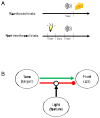Setting the occasion for adolescent inhibitory control
- PMID: 27864087
- PMCID: PMC5432413
- DOI: 10.1016/j.nlm.2016.11.010
Setting the occasion for adolescent inhibitory control
Abstract
During adolescence, individuals experience a broad range of dynamic environments as they strive to establish independence. Learning to respond appropriately in both new and previously encountered environments requires that an individual identify and learn the meaning of cues indicating that a behavior is appropriate, or alternatively, that it should be altered or inhibited. Although the ability to regulate goal-directed behavior continues to develop across adolescence, the specific circumstances under which adolescents experience difficulty with inhibitory control remain unclear. Here we review recent findings in our laboratory that address how adolescents learn to proactively inhibit a response. Much of our research has utilized a negative occasion setting paradigm, in which one cue (a feature) gates the meaning of a second cue (a target). The feature provides information that resolves the ambiguity of the target and indicates the appropriate behavioral response to the target. As such, we have been able to determine how adolescents learn about ambiguous stimuli, such as those whose meaning changes in accordance with other features of the surrounding environment. We consider why adolescents in particular exhibit difficulty in negative occasion setting compared to either pre-adolescents or adults. In addition, we review findings indicating that a balance in neural activity between orbitofrontal cortex and nucleus accumbens is necessary to support normal negative occasion setting. Finally, we consider aspects of associative learning that may contribute to adolescent inhibitory control, as well as provide insight into adolescent behavior as a whole.
Keywords: Adolescence; Inhibition; Learning.
Copyright © 2016 Elsevier Inc. All rights reserved.
Figures






Similar articles
-
Selective Modulation of Orbitofrontal Network Activity during Negative Occasion Setting.J Neurosci. 2017 Sep 27;37(39):9415-9423. doi: 10.1523/JNEUROSCI.0572-17.2017. Epub 2017 Aug 28. J Neurosci. 2017. PMID: 28847808 Free PMC article.
-
Imbalanced Activity in the Orbitofrontal Cortex and Nucleus Accumbens Impairs Behavioral Inhibition.Curr Biol. 2016 Oct 24;26(20):2834-2839. doi: 10.1016/j.cub.2016.08.034. Epub 2016 Sep 29. Curr Biol. 2016. PMID: 27693139 Free PMC article.
-
The ontogeny of learned inhibition.Learn Mem. 2014 Feb 18;21(3):143-52. doi: 10.1101/lm.033787.113. Learn Mem. 2014. PMID: 24549569 Free PMC article.
-
Occasion setting, inhibition, and the contextual control of extinction in Pavlovian and instrumental (operant) learning.Behav Processes. 2017 Apr;137:64-72. doi: 10.1016/j.beproc.2016.10.003. Epub 2016 Oct 6. Behav Processes. 2017. PMID: 27720958 Free PMC article. Review.
-
Occasion setting.Behav Neurosci. 2019 Apr;133(2):145-175. doi: 10.1037/bne0000306. Behav Neurosci. 2019. PMID: 30907616 Free PMC article. Review.
Cited by
-
Pre-adolescent stress disrupts adult, but not adolescent, safety learning.Behav Brain Res. 2021 Feb 26;400:113005. doi: 10.1016/j.bbr.2020.113005. Epub 2020 Nov 7. Behav Brain Res. 2021. PMID: 33171149 Free PMC article.
-
Basolateral amygdala and orbitofrontal cortex, but not dorsal hippocampus, are necessary for the control of reward-seeking by occasion setters.Psychopharmacology (Berl). 2023 Mar;240(3):623-635. doi: 10.1007/s00213-022-06227-0. Epub 2022 Sep 3. Psychopharmacology (Berl). 2023. PMID: 36056949 Free PMC article.
-
Translating Developmental Neuroscience to Understand Risk for Psychiatric Disorders.Am J Psychiatry. 2019 Mar 1;176(3):179-185. doi: 10.1176/appi.ajp.2019.19010091. Am J Psychiatry. 2019. PMID: 30818985 Free PMC article. Review.
-
Serotonin 1B receptor effects on response inhibition are independent of inhibitory learning.Neurobiol Learn Mem. 2022 Jan;187:107574. doi: 10.1016/j.nlm.2021.107574. Epub 2021 Dec 12. Neurobiol Learn Mem. 2022. PMID: 34902574 Free PMC article.
References
-
- Adriani W, Chiarotti F, Laviola G. Elevated novelty seeking and peculiar d-amphetamine sensitization in periadolescent mice compared with adult mice. Behavioral Neuroscience. 1998;112:1152–1166. - PubMed
-
- Stansfield KH, Kirstein CL. Effects of novelty on behavior in the adolescent and adult rat. Developmental Psychobiology. 2006;48:10–15. - PubMed
-
- Spear LP. The Behavioral Neuroscience of Adolescence. New York: Norton; 2010.
-
- Crone EA, Dahl RE. Understanding adolescence as a period of social–affective engagement and goal flexibility. Nature Reviews Neuroscience. 2012;13:636–650. - PubMed
Publication types
MeSH terms
Grants and funding
LinkOut - more resources
Full Text Sources
Other Literature Sources
Medical
Research Materials

